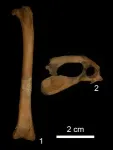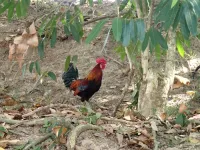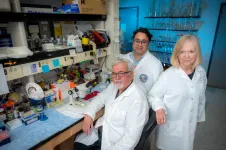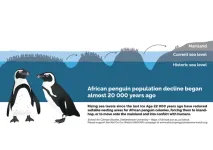(Press-News.org) LA JOLLA, CA— A new HIV vaccine from Scripps Research has shown a significantly improved ability to neutralize the virus in preclinical tests, and it will soon be studied in healthy people who volunteer to participate in clinical trials.
The new and unique vaccine design, described in a paper in Nature Communications on April 9, 2023, uses tiny protein “nanoparticles” to display multiple copies of HIV’s surface protein Env, thus presenting itself to the immune system much as real HIV particles would without causing HIV infection. The key innovation that explains its effects has to do with flexible sugar molecules called glycans, which normally cover Env on the real virus but are shortened in the new design. After achieving promising preclinical results, the National Institutes of Health (NIH) has agreed to sponsor a future clinical trial.
“With this design we appear to have solved a big piece of the HIV vaccine puzzle,” says the paper’s senior author Jiang Zhu, PhD, an associate professor in the Department of Integrative Structural and Computational Biology at Scripps Research.
The co-first authors of the study were postdoctoral associates Yi-Nan Zhang, PhD and Aleksandar Antanasijevic, PhD; scientific collaborator Jennifer Paynter, PhD; and postdoctoral associate Joel Allen, PhD, from the laboratory of vaccinologist Max Crispin, DPhil, professor at the University of Southampton.
The Joint United Nations Programme on HIV/AIDS (UNAIDS) estimates that 38.4 million people worldwide are currently living with HIV, and 1.5 million people became newly infected with HIV in 2021 alone. Apart from very rare cases involving bone marrow transplants, there is no cure for the infection, which must be held in check indefinitely with antiviral drugs to keep it from progressing to the deadly immune deficiency condition known as AIDS.
One of the defense strategies the virus uses is to shield its most exposed structure, Env, with glycans. Glycans are simple, chain-like molecules that are made by human cells to carry out various essential functions. Env contains sites where glycans will automatically fasten, so that when it is inside a human host, it ends up largely covered by them.
Glycans are difficult for antibodies to grip, and anything coated in them appears less like a foreign invader to the immune system. At the same time, Env proteins typically leave some of their less critical, more mutable parts uncovered by glycans, harmlessly diverting much of the antibody response.
While the best way to present glycans on the Env proteins used in vaccines is still a subject of lively debate among researchers, Zhu and his team took their vaccine design in a unique direction: not by removing glycans or adding them to no-glycan regions as some designs do, but instead simply by shortening their lengths. They reasoned that this would reduce the decoy power of no-glycan regions by reducing their contrast with glycan-dense regions—while simultaneously making vulnerable sites on the virus more accessible to antibodies. They also suspected that the desirable antibodies that can use glycans to hit Env would still be able to grip the trimmed glycans.
They designed experiments to test their predictions. Animal studies showed better antibody binding to key vulnerable sites on Env, and less binding to decoy sites. Moreover, in vaccinated animal models, the trimmed-glycan version of the vaccine induced strikingly stronger virus-neutralizing antibody responses compared to the non-trimmed-glycan version.
“In one test in mice, for example, seven out of eight immunized animal models generated robust neutralizing antibody responses, compared to only one of eight for the non-glycan-trimmed version,” Zhu says. “The difference with the glycan trimming was rather striking.”
The journey also extends beyond the lab and into the product development front. “As the exclusive licensee of this advanced vaccine platform technology, Uvax Bio is completing the GMP production of two vaccine candidates, namely, the wild-type Uvax-1197 and trimmed-glycan Uvax-1107,” added Ji Li, CEO of Uvax Bio.
In advance of the NIAID-supported clinical trial, Zhu and colleagues will do further experiments to confirm the specific antibodies, Env binding sites, glycan interactions and other vaccine components that are most important to test in this new vaccine candidate. A clinical trial may start as early as 2024.
“Single-component multilayered self-assembling protein nanoparticles presenting glycan-trimmed uncleaved prefusion optimized envelope trimers as HIV-1 vaccine candidates” was co-authored by Yi-Nan Zhang, Jennifer Paynter, Aleksandar Antanasijevic, Mor Eldad, Yi-Zong Lee, Jeffrey Copps, Linling He, Ian Wilson, Andrew Ward, and Jiang Zhu, of Scripps Research; Joel Allen, Maddy Newby, and Max Crispin of the University of Southampton; and Deborah Chavez, Pat Frost, Anna Goodroe, John Dutton, Robert Lanford and Christopher Chen of the Southwest National Primate Research Center.
Support for the research was provided by the International AIDS Vaccine Initiative (IAVI) (INV-008352/OPP1153692, INV-034657, INV-008352/OPP1153692), the Bill and Melinda Gates Foundation; the Scripps Consortium for HIV/AIDS Vaccine Development (CHAVD 1UM1 AI144462); the National Institutes of Health (P01 AI124337, R01 AI129698, R01 AI140844), the Southwest National Primate Research Center (P51 OD011133 and U42OD010442), Tulane National Primate Research Center (P51 OD011104), and UVAX BIO, LLC.
About Scripps Research
Scripps Research is an independent, nonprofit biomedical institute ranked one of the most influential in the world for its impact on innovation by Nature Index. We are advancing human health through profound discoveries that address pressing medical concerns around the globe. Our drug discovery and development division, Calibr, works hand-in-hand with scientists across disciplines to bring new medicines to patients as quickly and efficiently as possible, while teams at Scripps Research Translational Institute harness genomics, digital medicine and cutting-edge informatics to understand individual health and render more effective healthcare. Scripps Research also trains the next generation of leading scientists at our Skaggs Graduate School, consistently named among the top 10 US programs for chemistry and biological sciences. Learn more at www.scripps.edu.
END
Trim the sugar: New HIV vaccine design improves immune response
Scripps Research vaccine candidate headed for clinical trials.
2023-04-20
ELSE PRESS RELEASES FROM THIS DATE:
Immediate carbon cuts, common marine heatwave terminology urged
2023-04-20
Over the past two hundred years, the ocean and atmosphere have been accumulating massive amounts of carbon dioxide as factories, automobiles, airplanes, and more churn out the powerful greenhouse gas. Two articles published recently in Nature by University of Hawai‘i at Mānoa oceanographers provide a reality check on the limitations of carbon dioxide removal and a warning that marine heatwaves need clear definitions so communities can adapt.
Carbon dioxide removal is not the golden ticket
In all the scenarios assessed by the Intergovernmental Panel on Climate Change, nations around the world must dramatically and rapidly reduce their dependence ...
Paul Hessburg receives Distinguished Landscape Ecologist Award
2023-04-20
Paul Hessburg received the International Association for Landscape Ecology-North America Chapter’s 2023 Distinguished Landscape Ecologist Award. The annual award recognizes major scientific contributions to landscape ecology, honors scientists who have played a pivotal role in shaping the field, and is the organization’s highest honor.
Hessburg is a senior research ecologist with the USDA Forest Service's Pacific Northwest Research Station based at the Wenatchee Forestry Sciences Laboratory. He was honored for a highly diverse career that has "greatly enhanced the capacity of landscape practitioners to develop strategies and ...
Cut council tax for green gardeners to help cities tackle climate change
2023-04-20
Homeowners should be rewarded to garden sustainably, new research by Professor of Environmental Horticulture at University of Sheffield, recommends
Rewards for sustainable gardening could include reductions to council tax, water bills or assistance with resources
Ensuring urban gardeners have the ability to have planted gardens will have numerous benefits for the environment and communities
Banning environmentally damaging materials, such as pesticides; or practices such as installing astroturf, could also benefit the environment
Research shows that some cities may have lost as much as 50 per cent of their green garden space over the last ...
Online tool found to be effective at assessing dementia risk
2023-04-20
Researchers at UNSW Sydney and Neuroscience Research Australia (NeuRA) have developed and evaluated a tool for assessing dementia risk, with promising initial results.
Currently, over 55 million people are living with dementia around the world, with that number set to increase to 78 million by 2030, and the focus on dementia research increasingly shifting towards prevention.
The online tool takes approximately 20 minutes to complete and provides a personalised dementia risk report that patients can discuss with their doctor.
Since developing the risk tool – known as CogDRisk – in 2022, the team has been evaluating the success of the tool, by trialling it on four existing datasets, ...
A myth no more: Cranberry products can prevent urinary tract infections for women
2023-04-20
Drinking cranberry juice has long been a mythical prevention strategy for women who develop a urinary tract infection – and new medical evidence shows consuming cranberry products is an effective way to prevent a UTI before it gets started.
A global study looking at the benefits of cranberry products published in Cochrane Reviews has determined cranberry juice, and its supplements, reduce the risk of repeat symptomatic UTIs in women by more than a quarter, in children by more than half, and in people susceptible to UTI following medical interventions by about ...
Recycling lake sediments for crop production: A sustainable solution for closing the phosphorus cycle
2023-04-20
A four-year field experiment conducted on the shores of restored Lake Mustijärv in Viljandi, Estonia, has revealed that recycling phosphorus-rich lake sediments back to agriculture could have positive impacts on crop production.
The study was conducted by doctoral researcher Mina Kiani and the AgriChar research group, and it is globally the first of its kind to cover the environmental aspects of recycling lake sediments to agriculture over several years. Kiani defends her thesis on 21 April at the University of Helsinki Faculty of Agriculture and Forestry.
The study aimed to find a sustainable solution for closing the leaking agricultural phosphorus (P) cycle by recycling P-rich ...
Chicken breeding in Japan dates back to fourth century BCE
2023-04-20
Conclusive evidence of chicken breeding in the Yayoi period of Japan has been discovered from the Karako-Kagi site.
The chicken is one of the most common domesticated animals, with a current estimated population of over 33 billion individuals. They are reared for their meat and eggs, and may be kept as pets.
The chicken is believed to have been domesticated in Southeast Asia about 3500 years ago, following which they were carried to all corners of the world. The exact date of introduction of chicken breeding to Japan is under debate, as there are no historical records and archeological evidence ...
Protecting the vision of premature babies
2023-04-20
AUGUSTA, Ga. (April 20, 2023) – In the spiraling cycle that can lead to vision loss in premature newborns, Medical College of Georgia scientists have found a new target and drug that together appear to stop the destruction in its tracks.
In babies, the development of the blood vessels of the retina should be complete by birth. But with preterm birth, the still-immature retina can develop a potentially blinding eye disorder known as retinopathy of prematurity.
When premature babies transition from inside the womb, where ...
African penguins: climate refugees from a distant past?
2023-04-20
Imagine the view from the western coastline of southern Africa during the Last Glacial Maximum (LGM) over twenty thousand years ago: in the distance you would see at least fifteen large islands – the largest 300 square kilometres in area – swarming with hundreds of millions of marine birds and penguin colonies.
Now imagine sea levels rising up to a hundred metres between fifteen to seven thousand years ago, gradually covering these large islands until only small hill tops and outcrops remained above water. Over the past 22 000 years this resulted in a tenfold ...
New study challenges the idea that early Parkinson’s Disease causes cognitive dysfunction
2023-04-19
Like many neurodegenerative diseases, Parkinson’s disease (PD) is a thief that hacks into human operating systems and corrupts their cognitive hard drives until they can no longer control their movements or perform activities of daily living.
Often, in its later stages, Parkinson’s disease steals data too, leading to memory loss, confusion and dementia.
Both the cause and cure of Parkinson’s disease remain elusive, but research has helped afflicted individuals manage their symptoms and lead healthier post-diagnosis lives. Individuals diagnosed with Parkinson’s ...
LAST 30 PRESS RELEASES:
New expert guidance urges caution before surgery for patients with treatment-resistant constipation
Solar hydrogen can now be produced efficiently without the scarce metal platinum
Sleeping in on weekends may help boost teens’ mental health
Study: Teens use cellphones for an hour a day at school
After more than two years of war, Palestinian children are hungry, denied education and “like the living dead”
The untold story of life with Prader-Willi syndrome - according to the siblings who live it
How the parasite that ‘gave up sex’ found more hosts – and why its victory won’t last
When is it time to jump? The boiling frog problem of AI use in physics education
Twitter data reveals partisan divide in understanding why pollen season's getting worse
AI is quick but risky for updating old software
Revolutionizing biosecurity: new multi-omics framework to transform invasive species management
From ancient herb to modern medicine: new review unveils the multi-targeted healing potential of Borago officinalis
Building a global scientific community: Biological Diversity Journal announces dual recruitment of Editorial Board and Youth Editorial Board members
Microbes that break down antibiotics help protect ecosystems under drug pollution
Smart biochar that remembers pollutants offers a new way to clean water and recycle biomass
Rice genes matter more than domestication in shaping plant microbiomes
Ticking time bomb: Some farmers report as many as 70 tick encounters over a 6-month period
Turning garden and crop waste into plastics
Scientists discover ‘platypus galaxies’ in the early universe
Seeing thyroid cancer in a new light: when AI meets label-free imaging in the operating room
Neutrophil-to-lymphocyte ratio may aid risk stratification in depressive disorder
2026 Seismological Society of America Annual Meeting
AI-powered ECG analysis offers promising path for early detection of chronic obstructive pulmonary disease, says Mount Sinai researchers
GIMM uncovers flaws in lab-grown heart cells and paves the way for improved treatments
Cracking the evolutionary code of sleep
Medications could help the aging brain cope with surgery, memory impairment
Back pain linked to worse sleep years later in men over 65, according to study
CDC urges ‘shared decision-making’ on some childhood vaccines; many unclear about what that means
New research finds that an ‘equal treatment’ approach to economic opportunity advertising can backfire
Researchers create shape-shifting, self-navigating microparticles
[Press-News.org] Trim the sugar: New HIV vaccine design improves immune responseScripps Research vaccine candidate headed for clinical trials.







